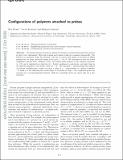Configurations of polymers attached to probes
Author(s)
Bubis, Roy; Kantor, Yacov; Kardar, Mehran
DownloadKardar_Configurations of.pdf (223.6Kb)
OPEN_ACCESS_POLICY
Open Access Policy
Creative Commons Attribution-Noncommercial-Share Alike
Terms of use
Metadata
Show full item recordAbstract
We study polymers attached to spherical (circular) or paraboloidal (parabolic) probes in three (two) dimensions. Both self-avoiding and random walks are examined numerically. The behavior of a polymer of size R[subscript 0] attached to the tip of a probe with radius of curvature R, differs qualitatively for large and small values of the ratio s=R[subscript 0]/R. We demonstrate that the scaled compliance (inverse force constant) S/R[2 over 0], and scaled mean position of the polymer end-point (x[subscript ⊥])/R can be expressed as a function of s. Scaled compliance is anisotropic, and quite large in the direction parallel to the surface when R[subscript 0]~R. The exponent γ, characterizing the number of polymer configurations, crosses over from a value of γ[subscript 1] – characteristic of a planar boundary – at small s to one reflecting the overall shape of the probe at large s. For a spherical probe the crossover is to an unencumbered polymer, while for a parabolic probe we cannot rule out a new exponent.
Date issued
2009-11Department
Massachusetts Institute of Technology. Department of PhysicsJournal
EPL (Europhysics Letters)
Publisher
IOP Publishing
Citation
Bubis, Roy, Yacov Kantor, and Mehran Kardar. “Configurations of Polymers Attached to Probes.” EPL (Europhysics Letters) 88, no. 4 (November 1, 2009): 48001.
Version: Original manuscript
ISSN
0295-5075
1286-4854